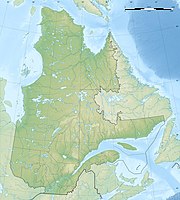Chicobi Ecological Reserve
|
Chicobi Ecological Reserve
|
||
| location | Abitibi , Quebec, Canada | |
| surface | 21.23 km² | |
| WDPA ID | 308495 | |
| Geographical location | 48 ° 51 ′ N , 78 ° 34 ′ W | |
|
|
||
| Setup date | 2002 | |
| administration | MDDEP | |
The Réserve écologique Chicobi is a 21.23 km² protected area in the west of the Canadian province of Québec on Lac Chicobi near Guyenne, around 45 km from Amos .
As part of the province's protected area system, the park represents the county municipality of Abitibi and in particular the hilly landscapes such as the Tanginan Collines , which are just as typical of the region as the plains rich in peatlands.
The Collines Tanginan, a range of hills, form the backbone of the reserve. They rise up to 440 m , while the lowlands are around 290 m above sea level. It is a typical post-glacial landscape that, unlike the surrounding area, was never used for agriculture.
More than a third of Abitibi's plant species can be found in the small protected area. The boreal forest is dominated by the black spruce ( French épinette noire ), which prefers moist, slowly draining locations.
There are still many such peat-rich areas in Canada, in contrast to Europe. They are particularly threatened by dam construction. As a result of the floods alone, 120,000 hectares of peatland in Québec disappeared, a total of 174,000 hectares. The second most common cause of losses is drainage for forestry. In the neighboring New Brunswick, on the other hand, peat cutting is the greatest threat to horticulture. But while the provinces of Manitoba , Nova Scotia , Prince Edward Island and New Brunswick have placed a larger part of these areas under protection, namely 25, 15, 12.5 and 11% of the areas, this proportion is only 3.6% in Québec. The province has peat soils totaling 118,263 km². Overall, they take up 17% of the land area in Canada, with the greatest threat to the soil coming from agriculture.
By the year 2000, only 16,445 hectares were protected in Québec, which was about 0.1% of the total area. This proportion rose to 36,895 hectares in parks by 2008 and a further 383,001 in biodiversity areas since 2002. At that time there were 69 écologiques reserves in Québec . The oldest protected area for moors was created in 1978 with Pointe-Heath . Although the ecological value of the area was recognized by the early 1970s at the latest, it was not until 2002 that it was placed under protection.
Web links
- Réserve écologique Chicobi , government website
Remarks
- ↑ Monique Poulin, Line Rochefort, Stéphanie Pellerin, Jacques Thibault: Threats and protection for peatlands in Eastern Canada , in: GeoCarrefour 79.4: La conservation des tourbières (2008), pp. 331-344.
- ↑ Monique Poulin, Line Rochefort, Stéphanie Pellerin, Jacques Thibault: Threats and protection for peatlands in Eastern Canada , in: GeoCarrefour 79.4: La conservation des tourbières, pp. 331-344, Figure 1.
- ^ Leopold Gaudreau: La reserve ecologique potential du lac Chicobi, Guyenne, Abitibi-Ouest , o. O. 1973.
